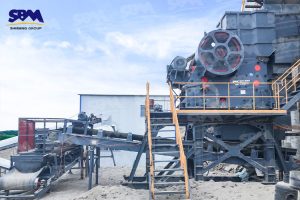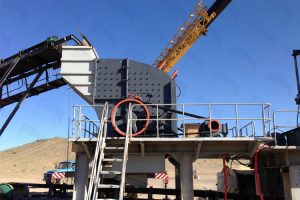Summary:This guide provides essential information for selecting the most suitable primary stone crusher for your operation. Different crusher types are analyzed, from traditional jaw and gyratory crusher to impact crusher.
Primary crushing is the first step of most rock crushing processes within mining and other industrial sectors. At this stage, large raw materials such as ores, minerals, quarry rocks and construction debris are reduced in size to outputs suitable for further downstream processing. The type of primary crusher selected has a significant impact on production efficiency, costs and overall process optimization.
This article explores the primary crusher options available and factors to consider when making the choice to best suit individual applications. With a clear understanding of equipment specifications and project needs, the right selection lays the foundation for successful project execution.
Each has distinct characteristics making one better suited for certain applications than others. Understanding their workings, capabilities and limitations enables selection of the most appropriate unit.
The three main crushers considered for primary crushing:
1.Jaw Crusher
2.Gyratory Crusher
3.Impact Crushers
One of the most widely used primary crushers is the jaw crusher. Jaw crusher is robust, reliable, and capable of handling large feed sizes, making them a popular choice for primary crushing applications. They utilize a fixed and a movable jaw to gradually reduce the material size through a compressive action. Jaw crushers are well-suited for hard, abrasive, and moderately soft materials, and their simple design and low maintenance requirements contribute to their widespread adoption.

Structure: Jaw crusher typically consist of a stationary jaw and a moving jaw. The latter exerts pressure on the trapped material in a crushing motion against the fixed jaw.
Feed Size: Jaw crusher can process feed sizes up to 1200 mm depending on the model. La
rger feed openings lead to higher throughput capacities.
Applications: Suitable for most rock and mineral types, with a maximum compressive strength of 320 MPa. Widely utilized initially to break larger run-of-mine rock for further secondary classification.
Operation: Jaw crusher operates in a stop-start motion and require consistent feeding to function optimally without clogging. Best for intermittent crushing and materials with low abrasiveness.
Throughput: Production capacities range from 50-600 tph. Single toggle models are lower capacity than double toggle varieties.
Advantages: Robust, reliable construction. Low capital and maintenance costs. Can operate profitably at lower production rates than gyratories and impactors.
Limitations: Unsuitable for sticky, mud-like feeds prone to jamming. Produces more fines than other crusher types due to squeezing action. Higher wear on moving parts demands frequent replacement.
Equipped with an oscillating crushing head inside a hollow shell on an eccentric axis, gyratory crusher provides a continuous crushing action. They are suitable for reducing large ores and rocks from 1000mm to below 50mm. Gyratory crusher can accept harder and more abrasive feed than jaw crushers while operating continuously. Higher capacity gyratory crushers process 500-9000 tph using larger machines requiring permanent foundations.

Structure: Consisting of a cylindrically mounted cone lined with wear parts, a gyratory crusher has an oscillating shaft fitting within the main frame. It crushes simultaneously from top and bottom using compression.
Feed Size: Larger gyratory crusher has openings up to 1600 mm, crushing rocks up to 1370 mm in diameter.
Applications: Suitable for semi-abrasive to abrasive rocks with compressive strengths under 600 MPa due to continuous operability with fewer fines produced. Commonly utilized for primary limestone crushing.
Operation: Gyratory crusher function continuously, are less prone to clogging and facilitate automated operation. They accept higher moisture contents than comparable jaw units.
Throughput: Units process 500-9000 tph depending on size, feeding chutes, grinding chamber capacities and motor power.
Advantages: Continuous operation prevents backups. Handles variable feed sizes well. Produces cubical products enabling uniform blending downstream. Fewer fines ensures classification efficiency.
Limitations: High capital costs. Complex maintenance requiring specialized skills. Less flexible for low production operations. Over-designed for some small-scale applications.
In recent years, impact crusher has gained increasing attention as primary crushers, particularly in applications where a more cubical and uniform product shape is desired. Impact crushers use the kinetic energy of rapidly rotating hammers or blow bars to fracture the material upon impact. They are effective in reducing softer, less abrasive materials and can produce a more desirable end product gradation for certain applications.

Structure: Impact crusher uses high-speed rotating hammers or other impacting surfaces to fracture raw material against stationary impact plates inside the crusher chamber.
Feed Size: Main impact crusher suit inputs up to 300 mm, while smaller variants accept 150 mm feeds. Larger sizes and capacities available with tertiary and quaternary crushers.
Applications: Ideal for soft to medium-hard rocks with lower strength like limestone, gypsum, shale and clay. Also suitable for abrasive, non-abrasive and dry/wet materials.
Operation: Multi-impact crushing enables efficient one-stage processing, reducing energy consumption versus two-stage crushing. Adjustable rotor speed controls product gradation.
Throughput: Typical crushing capacities vary between 50-500 tph for different size crushers. Higher capacities possible with increasingly larger models.
Advantages: Low capital cost. Simple structure with fewer components versus gyratories and jaw crusher. Adjustable product size. Highly portable with minimal civil works required.
Limitations: Lower maximum feed size limits use mostly as secondary and tertiary crushers for smaller primary crushing products. Higher wear part costs than compression crushers due to impact duty.

Discover whether bauxite crushers in Tanzania are the ideal choice for your crushing needs. Explore key features, advantages, and compare options, including SBM’s bauxite crushers Tanzania crusher for sale, tailored to optimize your bauxite processing operations.
View More
Discover the benefits of a mini crusher plant and learn key considerations for choosing the right machine crusher for sale. Explore how Sbm’s innovative solutions can meet your business needs efficiently and cost-effectively.
View More
Discover where to find the best brick machine for sale in Africa. Explore leading manufacturers, essential features to consider, and top marketplaces to maximize your investment in high-quality brick-making machinery.
View More
Discover the most reliable ball milling machine maker in our comprehensive article. We evaluate leading manufacturers, key features, customer reviews, and highlight SBM’s superior equipment for industrial applications. Optimize your milling processes today!
View MoreWe value your feedback! Please complete the form below so that we can tailor our services to your specific needs.


B6X Belt Conveyor adopts C-type steel as the main beam. It takes the modular structure and uses optimized headstock and tailstock. It is equipped with reversed V-type adjustable supporting legs. The whole machine is stable and compact and can be easily installed. It is an ideal upgrading and substitute product of traditional belt conveyor.
GET QUOTE